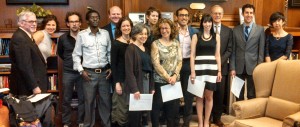Parents of children with autism are worried about changes in the fifth edition of the Diagnostic and Statistical Manual of Mental Disorders (DSM V), which will be published by the American Psychiatric Association this month. The manual defines the symptoms that characterize a particular condition or behavior and influences what services insurance companies pay for and what schools must provide.
The new DSM acknowledges that Autism is a spectrum by replacing subgroups such as Asperger’s Disorder, Autistic Disorder, and Pervasive Development Disorder Not Otherwise Specified (PDD-NOS) with a single umbrella condition called Autism Spectrum Disorder (ASD). The new DSM also recognizes that autism can occur with or without language disorder and may not necessarily show up in early childhood, depending on when social demands overwhelm a person’s ability to cope with them (see PLOS Biology cite below).
Some worry that the elimination of specific subgroups might make the new diagnosis criteria too stringent for some children See this 2012 New York Times story.
The advocacy organization Autism Speaks has an accessible FAQ for basics, including this key point:
First, all individuals who currently have a diagnosis on the autism spectrum, including those with Asperger syndrome or PDD-NOS, will not lose their ASD diagnosis. In other words, if you have a diagnosis for ASD, you have a diagnosis of ASD for your life and should be entitled to appropriate interventions for the rest of your life. Need for individualized services may change, and you or your child may need different levels of support or different interventions as you or your child age.
No one should be reevaluated or “lose” their diagnosis because of administrative reasons of the DSM-5.
Second, the revisions are intended to more reliably capture all those who would have legitimately received a diagnosis of ASD under DSM-IV. The intent is not to exclude or reduce the number of individuals being diagnosed. However, there is a need for ongoing monitoring of how the DSM-5 criteria affect diagnosis, especially those adults and very young children, two groups for whom we still have relatively little information. The committee has stressed that the new DSM-5 criteria represent a “living document,” in which changes can and likely will be made as new studies are conducted.
PLOS Biology published this paper last month by researchers, including much-cited expert Simon Baron-Cohen, offering a balanced commentary of the pros and cons. The conclusion is a nice re-statement of this adage: if you know one person with autism, you know one person with autism. Individual variability cannot be averaged away.
DSM-5 ASD criteria should be commended for its clearer symptom descriptions and grouping, for acknowledging the spectrum nature of autism, and for recognizing the dynamic nature of development and how individuals interact with their environment. Moreover, for clinical purposes a unitary label of ASD may be beneficial in planning the support systems for all individuals “on the spectrum” who require help from education and health- and social-care systems. However, it is important to remember that autism is not homogenous, and defining it using the umbrella term ASD risks whitewashing the evident heterogeneity, which has a substantial impact for research into this condition. The identification of core features of autism using the broader ASD label cannot overcome the existence of heterogeneity. It has simply moved us from the level of subgroups (“apples and oranges”) to the prototypical level (“fruit”). We argue that to make progress in autism research, and ultimately to improve clinical practice, we need to move forward in the identification of subgroups within the autism spectrum.
The consensus appears to be one of caution about how the new definitions will be applied in practical terms in clinics and school settings. Basically, wait and see before hitting the panic button.


